These compilations have been sourced from publicly available policy descriptions or reports.
 @Knut Troim on Unsplash
@Knut Troim on Unsplash
Asia Countries
ꔷ China
In January, the Ministry of Agriculture and Rural Affairs of China (MARA) released the 14th Five-Year Plan for National Fisheries Development. The plan highlights significant challenges in China’s fisheries governance, including inadequate implementation of fisheries laws and policies, challenges in implementing the Total Allowable Catch (TAC), and the need for reforms in fishing port and vessel management. The plan emphasizes China's commitment to green development and conservation of aquatic living resources. It sets out thematic targets and specific measures to achieve the development goals, including significant strengthening of the fisheries governance system and capacity by 2025 and the overall modernization of the fisheries industry by 2035.
In December, MARA issued the Guiding Opinions on strengthening the conservation of aquatic biological resources. The document emphasizes China's commitment to fisheries management reforms and improving the TAC system, port and vessel management, and enforcement capacity, by drawing upon international experience. The Opinions outline specific targets, including expanding TAC pilots by species and regions by 2025, and establishing a fisheries resource conservation system with balanced consideration of input and output controls by 2035. The goal is to halt the decline in the resources of the main economic species and ensure sustainable development of China's fisheries.
ꔷ Indonesia
In March, the Decree of the Indonesian Minister of Maritime Affairs and Fisheries No. 19 of 2022 on the Estimation of Fish Resources Potential, allowable amount of fish catch (JTB) and utilization level of fish resources in the Fisheries Management Areas of the Republic of Indonesia came into force. In April, Indonesia announced a fish resources potential of 12 million tonnes, the first time it had used international methodologies to make estimates. In order to increase industrial income and promote sustainable development, the Ministry is promoting the reform of Indonesia's fisheries from input management to output management, and plans to implement the TAC management policy in 2023. Quotas will be set by species and divided into commercial, traditional fishermen's and non-commercial quotas (for research, recreation, etc.). Commercial fishing allows foreign investors to participate. The Ministry is also working on other laws underpinning the TAC system, including quota allocation and regulations such as designated landings.
 Indonesian Fisheries Management Areas by Quota Type @ Indonesian Ministry of Maritime Affairs and Fisheries
Indonesian Fisheries Management Areas by Quota Type @ Indonesian Ministry of Maritime Affairs and Fisheries
ꔷ Japan
In March, Japan's cabinet approved a new Fishery Basic Plan. The Fisheries Basic Plan, formulated in accordance with Japan’s Fisheries Basic Act and revised every five years, aims to comprehensively and systematically guide the development of fisheries, covering other fishery industries such as fishery, aquaculture, and distribution and processing. The new plan establishes three pillars for the next decade: steady implementation of new resource management, transformation into growth industries, and revitalization of fishing villages. Among them, the implementation of new resource management mainly refers to following the revised Fishery Act of 2020 and the Fishery Resources Management Roadmap, achieving a return of production in 2030 to 2010 levels (4.44 million tons) through increased resource surveys and stock assessment, expansion of TAC management of species and introduction of individual quota systems, strengthening MCS and adapting to changes in the marine environment.
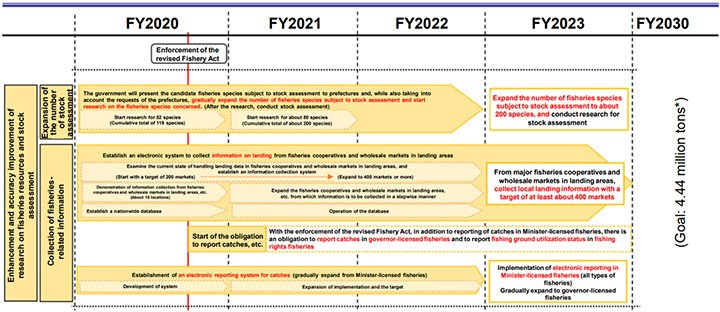 Resource Assessment and Information Collection for the Fishery Resources Management Roadmap @ Japan Fisheries Agency
Resource Assessment and Information Collection for the Fishery Resources Management Roadmap @ Japan Fisheries Agency
In November, Japan released the 2021 Fisheries White Paper. In addition to reviewing past and updated fisheries basic plans, and analyzing the impact of COVID-19 on the fishery industry and how to cope with it, the white paper describes the current situation of fisheries in 2021 and trends in 2022. Progress in advancing new resource management in 2021 includes an increase in the number of species assessed from 119 in 2020 to 192 species, close to the target of 200 by the end of 2023; 8 species (60% of the total catch) started implementing MSY-based TAC management; individual quotas were introduced into the 2021 fishing season for medium and large purse seine mackerel.
ꔷ Korea
In July, South Korea began TAC management of hairtail, small yellow croaker and Spanish mackerel. This increased the number of TAC-managed species and fishery types to 17 in South Korea. Among them, 11 species’ TAC were determined by the central government, and 4 species (mainly shellfish) were determined by the local government. The expansion extends TAC management coverage to 40% of total domestic catches. According to South Korea's "Fisheries Innovation 2030" reform plan, the Korean government will comprehensively build TAC-based resource management results, and the TAC management rate will reach 50% by 2025, 60% by 2027, and 80% by 2030. A two-year TAC pilot for anchovy also starts in July.
In November, the Legislative Research Office of the National Assembly Research Service of Korea published the "Analysis of the Legislative Impact of the Coastal Fishing Vessel Reduction Project under the Coastal Fishery Structure Improvement and Support Act." The report pointed out that the vessel reduction project carried out by the Republic of Korea since 1994 has not led to the recovery of fishery resources, and that the resources continue to decline; in line with this trend, the Korean government implemented the Second Basic Plan for the Optimization of Coastal Fishery Structure (2019-2023), the targets of 4 million tons of fishery resources and 1.1 million tons of coastal fishery production by 2022 by reducing coastal fishing vessels are expected to be difficult to achieve. The report proposes future directions for improvement, such as a thorough review of the effectiveness and appropriateness of methods for vessel reduction, a multi-angle analysis of the causes of declining resources and production, and strengthening livelihood stabilization measures for relocated fishers.
ꔷ Vietnam
In September, the Vietnamese government approved the Scheme for Preventing Illegal, Unreported and Unregulated (IUU) Fishing until 2025. The plan proposes that by 2025, all fishing vessels over 15 meters in length will be inspected before departing port to ensure that relevant documents and equipment comply with regulations; fishing vessels over 15 metres must be 100% monitored by the Position Monitoring System while at sea and inspected upon port entry; domestic catches must be inspected and monitored in accordance with regulations upon landing; foreign catches landed in Vietnam ports must be 100% inspected and monitored in accordance with the 2009 Agreement on Port State Measures (PSMA) of the Food and Agriculture Organization of the United Nations (FAO).
In September, the Vietnamese government approved the National Program for the development of effective and sustainable fishing for the period 2022 - 2025, with orientations to 2030. The overall objectives of the plan are to achieve sustainable fisheries with balanced fishing capacity and catchable resources, achieve high economic efficiency, improve operational safety and fishermen's living standards, etc. The plan mainly specifies the specific goals, main tasks, implementation plans and financial arrangements for 2025 and 2030. For example, in the case of fishing vessels, one of the targets for 2025 is to reduce the number of offshore fishing licenses by 10% compared to 2020, and all coastal provinces and municipalities need to determine fishing vessel quotas under their management. In 2030, the fleet structure, type of operation and total fishery production need to achieve targets set in the 2021-2030 Aquatic Resources Conservation and Development Plan with an eye to 2050.
European Countries
ꔷ European Union
In June, the European Commission published Communication from the Commission to the European Parliament and the Council - Towards more sustainable fishing in the EU: state of play and orientations for 2023. According to the report, the status of fishery stocks in EU waters improved in 2020, with the Northeast Atlantic achieving overall sustainable fishing at the Maximum Sustainable Yield (MSY) level for the first time, and fishing mortality in the Mediterranean region falling to the lowest since 2003, but the Baltic Sea has regressed due to historical overfishing and environmental problems. In terms of fleet, the number of EU-registered vessels at the end of 2021 was 74,380, 1,320,362 metric tons and 5,304,015 kW, but the credibility of the power data reported by Member States is in serious doubt. The biggest challenge to fleet profitability – fuel prices – has risen sharply since March 2022, with those highly dependent on fuels such as trawls being the most affected. In 2023, the EU will focus on continuing to improve fisheries management in the Mediterranean, advancing the implementation and enforcement of landing obligations, and improving data collection.
In September, the European Court of Auditors (ECA) published Special Report 20/2022: EU action to combat illegal fishing. The report reviews the EU framework, action and spending to combat illegal, unreported and unregulated fishing (IUU) between 2014 and 2020, with a focus on auditing the effectiveness of both the control system of Member States (MS) to check national fleets and for preventing the import of illegal seafood. The EU provided €580 million for monitoring, control and surveillance (MCS) during this period, effectively reducing the risk of IUU, but the effectiveness is reduced by the uneven application of checks and sanctions by MS. Major regulatory loopholes and penalties disproportionate to violations in some MS, have contributed to overfishing and underreporting. The EU's catch certification scheme set up in 2008 has also been undermined by differences in the scope and quality of checks by MS. The report recommends that the EU monitor and make sure MS implement more deterrent penalties and mandate the use of electronic traceability systems to reduce IUU risks effectively.
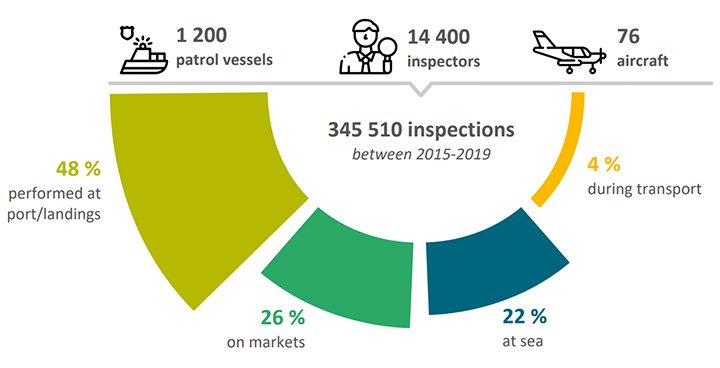 Resources allocated to control of fishing activities in EU waters or by the EU fleet @ECA
Resources allocated to control of fishing activities in EU waters or by the EU fleet @ECA
ꔷ Spain (EU Member State)
In December, the Spanish Congress approved the draft Law on Sustainable Fisheries and Fisheries Research, pending final approval by Parliament. The bill will amend the Spanish National Marine Fisheries Law, which has been in force since 2001, to further strengthen the principles of sustainability (economic, social and environmental) of Spanish fisheries, building on a series of developments in EU and international marine fisheries policy over the past 20 years. Priorities include establishing new quota allocation criteria, updating mechanisms for transferring fishing quotas or effort between vessels, and strengthening science-based policy support.
ꔷ Iceland
In October, Iceland's Minister of Food, Agriculture and Fisheries launched a comprehensive fisheries policy reform called "Our Resources". The goal of the reform is to "use marine resources more efficiently and sustainably in harmony with the environment and society", with a focus on addressing the inequities caused by the consolidation of fishing quotas and the irrational distribution of profits. The expert group appointed by the Minister conducted a review of the current management situation and mapped fishing rights relationships, and published the first draft of the proposal. The 60 proposals serve three objectives: environmental priority, value maximization and equitable distribution. This reform will eventually result in entirely new fisheries or marine resources laws.
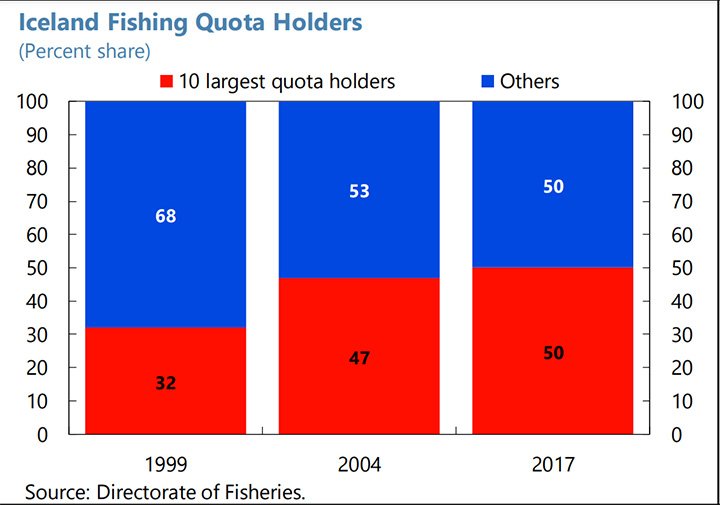 Icelandic fishing quotas are increasingly concentrated in a small number of holders @ Icelandic Fisheries Agency
Icelandic fishing quotas are increasingly concentrated in a small number of holders @ Icelandic Fisheries Agency
ꔷ Norway
In July, Norway fully implemented the Electronic Reporting System (ERS) for fishing vessels over 11 metres. In order to monitor and control fishing activities more effectively, as well as to collect catch data, Norway developed the Regulation on position reporting and electronic reporting of Norwegian fishing and hunting vessels in 2009 and introduced the stepwise implementation of ERS. ERS was made mandatory for fishing vessels over 15 meters in September 2021. According to the regulation, ERS reports include port departure reports, port arrival reports, and catch reports (at least once a day), and vessels involved in transshipment must send additional transshipment reports.
ꔷ United Kingdom
In November, the UK Fisheries Departments jointly issued the Joint Fisheries Statement (JFS). The UK's first landmark national fisheries law in 40 years, the Fisheries Act 2020, listed eight targets led by sustainability. The Act provides for the fisheries sector to define high-level, strategic directions for the future of fisheries management and specific policies to achieve the eight objectives through the development of a JFS. Among them, the development and implementation of fisheries management plans (FMPs) by stock, fishery type and geographical area will be a key tool for achieving sustainable fisheries.
North America
ꔷ Canada
In April, the fish stock provision amending Canada's Fisheries Act 2019 came into force. In order to further promote sustainable fisheries, the Fisheries and Oceans Canada made the tenth amendment to the Act, making stock rebuilding legally-binding the first time. The new provision requires that once the resources of major stocks fall below the limit reference point, Fisheries and Oceans Canada must develop stock rebuilding plans within three years. The plan must include specific elements such as the causes of for the decline, measurable objectives, rebuilding timeline, management measures and son on. The provision currently applies to 30 major fish stocks, 16 requiring rebuilding.
ꔷ United States
In March, NOAA Fisheries released its Annual Report on the State of Stocks and the 2020 U.S. Fisheries Report. The former shows that in 2021, more than 80% of the 460 stocks for which data are known were not overfished, and 51 stocks (two more than in 2020) were still overfished. The latter shows that in 2020, U.S. commercial catches were 8.4 billion pounds, worth $4.7 billion, and recreational anglers caught an estimated 1 billion fish and released 65 percent of them. Fish landings in the U.S. fell 10%, possibly due to COVID-19.
In April, NOAA Fisheries published a new tool, the Fisheries Distribution Map and Analysis Portal (DisMAP). The tool transforms historical survey data into a visual map showing the distribution areas of more than 800 species of fish and their changes over time to support conservation and management decisions. Available data show that many marine species are already migrating as a result of climate-induced changes in the marine environment, which have significant implications for fisheries management, such as quota allocation and the setting of closed zones.
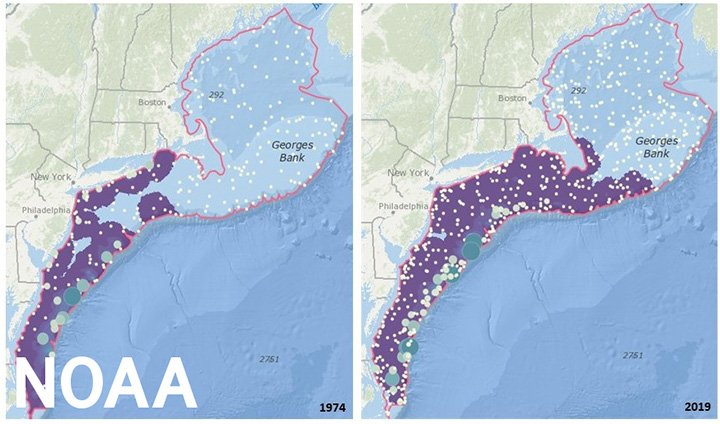 The DisMAP shows that species such as the Black Sea bass are migrating significantly north due to climate change@NOAA Fisheries
The DisMAP shows that species such as the Black Sea bass are migrating significantly north due to climate change@NOAA Fisheries
In December, NOAA Fisheries released its Fisheries Strategic Plan 2022-2025.The plan identifies three strategic objectives for the period: adaptive management of fisheries (especially climate change) to achieve sustainability and economic competitiveness, restoration of protected species, and promotion of equity and environmental justice. Each target has specific strategies, such as the goal of sustainability is supported by sub-strategies to promote climate science and ecosystem-based fisheries management, modernize data collection, and combat IUU fishing.
In December, NOAA Fisheries announced a proposal to expand the Seafood Import Control Program (SIMP). SIMP is a U.S. risk-based traceability system that requires U.S. importers to obtain permits and report and keep data from the point of catch to entry into the U.S. for certain fish and seafood with a high IUU risk to prevent IUU catch and mispresented seafood from entering U.S. commerce. The newly published proposal expands the existing 13 categories of about 1,100 species to 18 categories and 1,670 species, including octopus, cuttlefish, squid, eel and more.
Oceanic Countries
ꔷ Australia
In April, the Australian Government released its National Fisheries Plan 2022-2030. The plan sets out targets for sustainable growth in Australia's fishing, aquaculture and other marine industries in the future, identifies nine priority areas, and sets out specific targets and key actions in each area by 2030. For example, governance improvements were achieved through three actions, including strengthening cross-sectoral national electronic data collection systems; Achieving sustainable and healthy fishery resources through six actions, including ensuring that all fisheries are managed consistently with Guidelines for the ecologically sustainable management of fisheries; Achieve first-class international participation and market access through four actions, including strengthening seafood traceability systems.
In June, Australia's National Fisheries Compliance Committee released its 2022-2026 Fisheries Compliance Strategy. Although Australian fisheries management is considered one of the most advanced systems in the world, it still faces significant enforcement challenges, including the risk of overfishing, organised crime, increasingly complex regulations and limited enforcement resources. Australia defines an "optimal level of compliance" as " the level of non-compliance at an acceptable level, which can be maintained at a reasonable cost while not compromising the integrity and sustainability of the resource" and has established maximum voluntary compliance, effective deterrence and strengthening organizational and technical capacity building as three main strategies.
In November, the Australian Government released its State of Fisheries Report 2022. The Australian Department of Agriculture and Resource Economics and Science (ABARES) has published an independent evaluation annually since 1992 assessing the biological and economic state of federally managed or co-managed fishery stocks. This represents approximately 38% of Australia's total fisheries production, worth US$37.4 billion in 2021. The results show that fishery stocks were generally stable in 2021, with 81 of the 101 assessed stocks not subject to overfishing and 69 stocks above the level that produces MSY; however, overfished stocks increased by two compared to last year, to a total of 13.
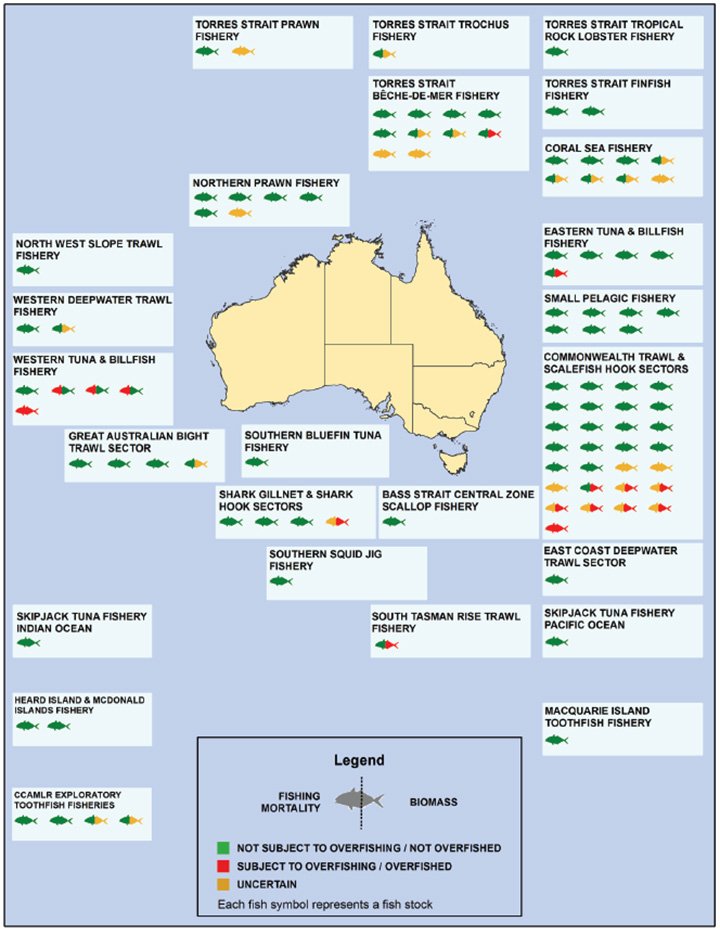 Biological status of fish stocks managed exclusively or jointly by the Australian Government in 2021 @ ABARES
Biological status of fish stocks managed exclusively or jointly by the Australian Government in 2021 @ ABARES
ꔷ New Zealand
In November, New Zealand's Fisheries Amendment Act came into force. The Act amends the Fisheries Act 1996 to include simplifying but strengthening quota management of landings and discarding of species and creating a tiered penalty system. The new system of penalties for non-compliance takes effect immediately, while there is a four-year transition period for landing and discard bans. This legislative amendment is part of New Zealand's implementation of the Fisheries Reform Plan. The objectives of the plan are to strengthen and modernize New Zealand fisheries management to ensure the sustainability of New Zealand's fisheries and to achieve economic, social and cultural values, including the introduction of mandatory e-catch and position reporting to improve the collection of fisheries data, the development of simple, fair and responsible fisheries rules and policies, and the enhancement of catch monitoring and verification capacity.
Others
In December, the Organisation for Economic Co-operation and Development (OECD) released its Fisheries Report 2022. The report analyses and summarizes the health of fishery stocks, management practices and government support in 32 countries or regions. In particular, the report notes that TAC is one of the most important tools for ensuring the health of fish stocks, despite the diversity of national approaches to fisheries management. The report assessed 313 stocks of the 107 species of the highest economic value in 29 countries or regions and found that more than three-quarters of the stocks were managed using TAC, second only to the gear limit (used for 87% of stocks). In 2020, fisheries production managed by TAC was 12.6 million tonnes, worth US$9.2 billion. This represents 81% of all production and 61% of the value of all species collected by the OECD. Species not covered by TAC and species not set at sustainable levels by TAC may be at risk of unsustainable fishing. The report recommends that increased use of TAC (and other quota mechanisms) helps ensure the economic, social and environmental sustainability of the most important fisheries.
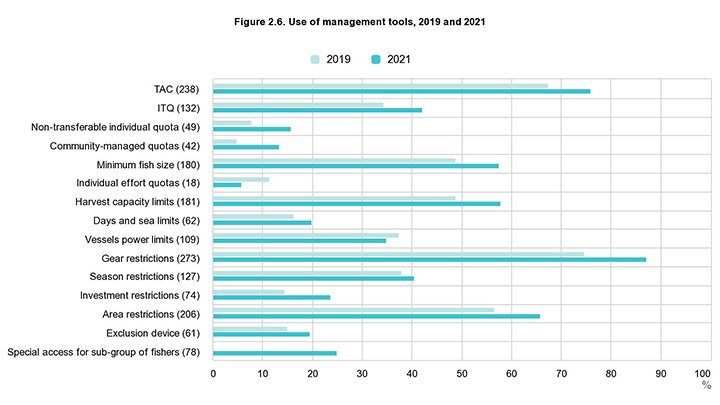 Use of national fisheries management tools in the OECD in 2019 and 2021 @OECD
Use of national fisheries management tools in the OECD in 2019 and 2021 @OECD
In 2022, the FAO published the technical guideline Understanding and implementing catch documentation schemes: A guide for national authorities. CDS is one of the tools to combat the IUU by providing information on the legality of the supply chain of fish products from fishing grounds to markets. The document describes the legal and policy background to CDS, the structure of the current systems as well as guidance on how to handle CDS information requirements and identify national key data elements, including emphasizing the need for robust national systems to validate and verify CDS information.


